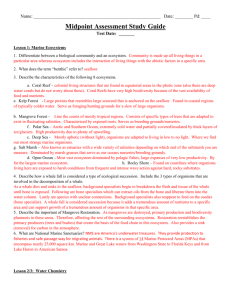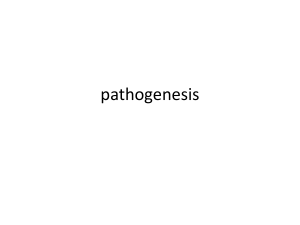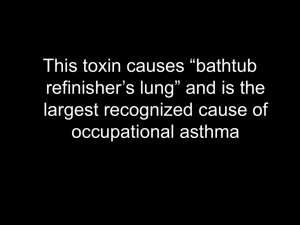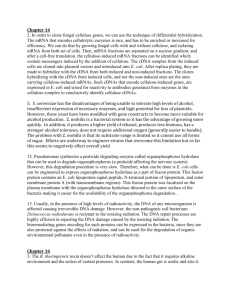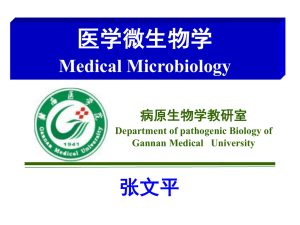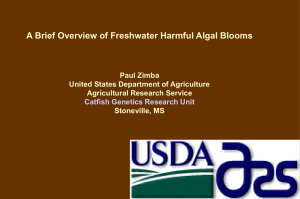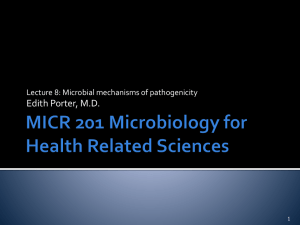Lesson 13-14 Study Guide Key
advertisement
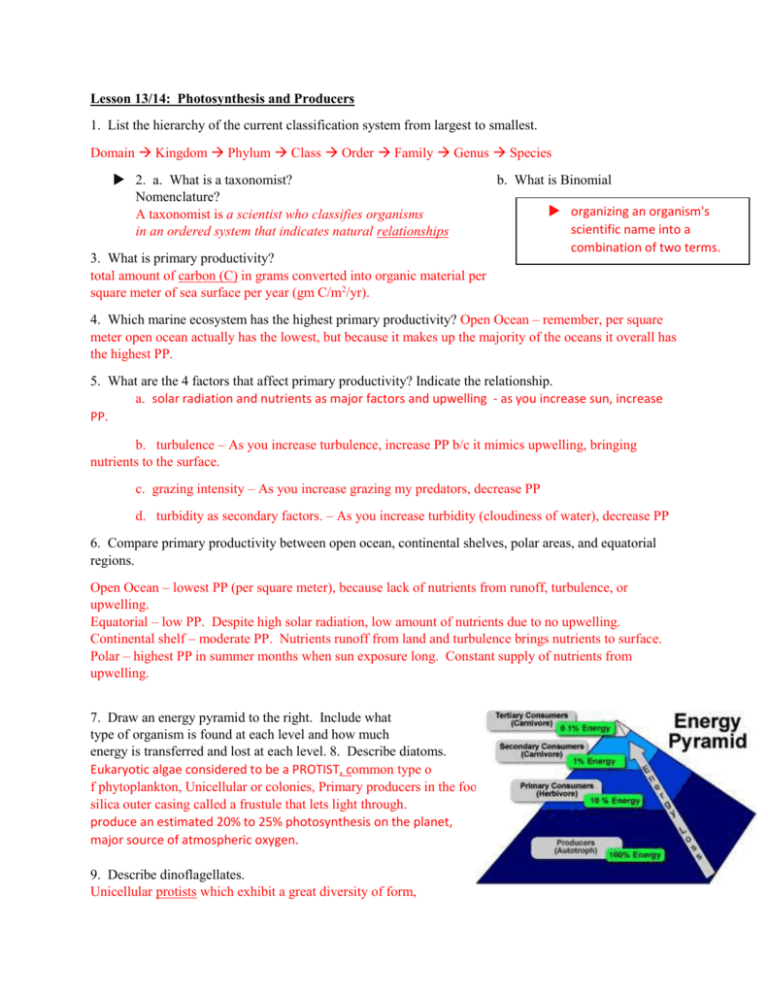
Lesson 13/14: Photosynthesis and Producers 1. List the hierarchy of the current classification system from largest to smallest. Domain Kingdom Phylum Class Order Family Genus Species 2. a. What is a taxonomist? Nomenclature? A taxonomist is a scientist who classifies organisms in an ordered system that indicates natural relationships b. What is Binomial 3. What is primary productivity? total amount of carbon (C) in grams converted into organic material per square meter of sea surface per year (gm C/m2/yr). organizing an organism's scientific name into a combination of two terms. 4. Which marine ecosystem has the highest primary productivity? Open Ocean – remember, per square meter open ocean actually has the lowest, but because it makes up the majority of the oceans it overall has the highest PP. 5. What are the 4 factors that affect primary productivity? Indicate the relationship. a. solar radiation and nutrients as major factors and upwelling - as you increase sun, increase PP. b. turbulence – As you increase turbulence, increase PP b/c it mimics upwelling, bringing nutrients to the surface. c. grazing intensity – As you increase grazing my predators, decrease PP d. turbidity as secondary factors. – As you increase turbidity (cloudiness of water), decrease PP 6. Compare primary productivity between open ocean, continental shelves, polar areas, and equatorial regions. Open Ocean – lowest PP (per square meter), because lack of nutrients from runoff, turbulence, or upwelling. Equatorial – low PP. Despite high solar radiation, low amount of nutrients due to no upwelling. Continental shelf – moderate PP. Nutrients runoff from land and turbulence brings nutrients to surface. Polar – highest PP in summer months when sun exposure long. Constant supply of nutrients from upwelling. 7. Draw an energy pyramid to the right. Include what type of organism is found at each level and how much energy is transferred and lost at each level. 8. Describe diatoms. Eukaryotic algae considered to be a PROTIST, common type o f phytoplankton, Unicellular or colonies, Primary producers in the food chain, silica outer casing called a frustule that lets light through. produce an estimated 20% to 25% photosynthesis on the planet, major source of atmospheric oxygen. 9. Describe dinoflagellates. Unicellular protists which exhibit a great diversity of form, many are photosynthetic, Some species are capable of producing their own light through bioluminescence, which also makes fireflies glow Harmful Algal Blooms Toxin 1: Okadaic Acid 1. What organism produces this toxin? The main organism that causes blooms is Dinophysis. 2. What type of organism is Dinophysis? dinoflagellate. 3. What sickness is caused by this toxin? Diarrheic Shellfish Poisoning (DSP) 4. How can you avoid getting this toxin? Avoid eating shellfish. 5. Where is Okadaic acid found? What season would it most likely occur? It is found in the Gulf of St. Lawrence in Eastern Canada, and Western Europe. Blooms occur in the summer. Toxin 2: Brevetoxin 1. What geographic locations do you find brevetoxins? Most common off of US Coast/Gulf of Mexico 2. What HAB creates brevetoxin? Karenia brevis 3. What ways can brevetoxin harm humans? Direct contact – consumption through infected shellfish/inhalation of toxin carried through the air. 4. What are some of the symptoms of being intoxicated with brevetoxin? nose, throat, jaw, coughing, wheezing, and shortness of breath 5. What is it called when infect shellfish is consumed by humans? (NSP) 6. What color are Karenia brevis blooms? Irritation of the eyes, Neurotoxic Shellfish Poisoning Red 7. Once brevetoxin enters your body, what does it target? junctions - Sodium channel at neuromuscular Toxin 3: Microcystins 1. What type of organism produces Microcystins? Dinoflagellate 2. What color does the bloom show up? Blue-green 3. Are the toxins marine or freshwater? Freshwater 4. What types of organisms can microcystins cause death in? 5. What type of years do the blooms peak? Fish, dogs, and small humans August to September 6. Where have notable blooms occurred in the US? Great Lakes (Lake Erie) Toxin 4: Ciguatoxin 1. Where is ciguatoxin commonly found? Tropical area/coral reefs 2. What main disease does ciguatoxin cause? Ciguatera food poisoning 3. What is the scientific name of the organism that produces ciguatoxin? 4. What fish are known to carry ciguatoxin? Gambierdiscus toxicus Barracuda, hagfish, snapper, and grouper 5. Describe the characteristics of the Gambierdiscus toxicus. many deep/dense pores Large, round, smooth cell surface, with Toxin 5: Saxitoxin 1. What is the organism that produces Saxitoxin? as Cyanobacteria Marine dinoflagellates like Alexandrium as well 2. What type of organisms does Saxitoxin accumate in? Shellfish 3. What disease is caused by eating saxitoxin contaminated shellfish? 4. How does the toxin cause paralysis in the body? membranes Paralytic Shellfish Poisoning By blocking sodium channels in nerve 5. How are organisms that become infected with the toxin treated? Given artificial respiration Toxin 6: Domoic Acid 1. What is the species that produces domoic acid? 2. What type of organism is this? Pseudo-Nitschzia Diatom 3. What is the disease/condition that ingestion of domoic acid causes? (ASP) 4. What is the common name of the bloom it causes? 5. Is this a freshwater or saltwater species? Amnesic Shellfish Poisoning Brown tide Saltwater Toxin 7: Pfiesteria 1. Where was the most widely covered Pfiesteria outbreak? Chesapeake Bay in 1997 2. What are some effects of intoxication by Pfiesteria? Short term memory loss, fatigue 3. What is the scientific name of this algal species? 4. What type of organisms is this? Pfiesteria piscicido Dinoflagellate 5. When is the most common time of year that this species blooms? Summer Lesson 14 Continued: 10. What is the difference between chemosynthesis and photosynthesis? Chemosynthesis – Organisms that use chemicals to produce organic compounds (sugars like glucose to live off). Autotrophs like this typically live in extreme environments like hydrothermal vents (at the depths of the ocean). Photosynthesis - Organisms that use light to produce organic compounds (sugars like glucose to live off) 11. Describe the difference between: a. Halophile – Organisms that lives in extremely salty lakes and seas. b. Methanogen – Bacteria that produce a natural gas called methane. Live in the guts of animals. c. Thermophile – Organism that thrives in extremely hot conditions, whether in fresh water or salt water. 12. Draw the Carbon Cycle. 13. Why is the Carbon Cycle so important to primary productivity? Ocean holds >90% of Earth’s Carbon Dioxide In addition to Photosynthesis, also used by molluscs to build their CaCo3 shells Plants take in CO2 to make carbohydrates Carbs get passed through food chain
